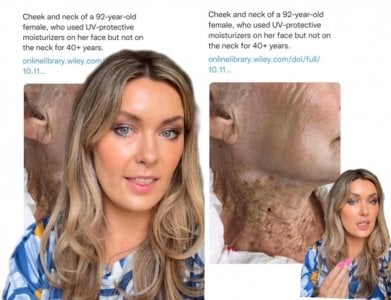Your sun protection routine should include this step – Studies have proven its importance
- Replies 3
It’s a simple fact: If you regularly apply sunscreen to your face, but not the back of your neck or the sides of your face, you won’t get the full SPF (sun protection factor) you intended or paid for.
Many people are aware of this, but they still don’t regularly apply lotion to every part of their body because it can be so time-consuming or perhaps they don’t want sunscreen to get on the sleeves of their clothes.
Hannah English, a pharmaceutical scientist from Melbourne, agrees that sunscreen is important. That’s why she shared a photo of a 92-year-old woman with serious sun damage to the skin of her neck after she only used UV protective moisturisers on her face (but not her neck) for 40 years to remind others to wear sunscreen everywhere.
In her Instagram post, Ms English revealed a ‘stark’ difference in the skin of the 92-year-old woman between her face and her neck, showing how vital it is to apply sunscreen everywhere. ‘Don't forget your neck and chest. And probably hands,’ she said.

UV Damage caused by the sun's rays can be extremely damaging to the skin, especially over longer periods of time. Credit: Hannah English
The woman in the photos had used sunscreen on her face for 40 years, as revealed by Ms English. However, she neglected to apply it to her neck, which resulted in visible damage.
Doctor Avi Bitterman, a New York dermatologist, originally shared the photos on social media. He wrote: ‘Cheek and neck of a 92-year-old female, who used UV-protective moisturisers on her face but not on the neck for more than 40 years.’
The images were published in the Journal of the European Academy of Dermatology and Venereology to emphasise the importance of using UV protection.
In Ms English’s post, she warned against anyone neglecting to apply sunscreen to their necks.
She wrote: ‘It’s not too late to start wearing SPF daily.’
She then added, ‘Don’t forget your neck and chest. And probably hands.’
This issue is a lot bigger than most people realise. According to a study from the Cancer Council, only 55% of Australian adults recognise that it’s safe to use sunscreen every day, down from 61% in 2014. 17% of respondents were worried that sunscreens contain ingredients that are bad for your health, while 20% believed that using sunscreen regularly would result in not having enough vitamin D.
Australians are generally under-applying sunscreen and not re-applying it regularly enough, leaving them vulnerable to the harmful effects of UV radiation.
UV exposure can lead to premature ageing of the skin, skin cancer, and cataracts. There is some truth to the saying ‘an ounce of prevention is worth a pound of cure’. Choosing to properly apply sunscreen could save your skin from damage..
Here are some tips on how to correctly apply sunscreen to our body:
1. Use sunscreen with an SPF of 30 or higher. 'SPF' stands for Sun Protection Factor. It is a measure of how well a sunscreen will protect your skin from harmful UV rays. The higher the SPF, the better the protection. We personally opt for SPF 50+ since Australia’s UV is so intense.
2. Apply sunscreen to all exposed skin, including the neck, face, ears, and hands. Don't forget to apply it to the tops of your feet if you are wearing sandals.
3. Use enough sunscreen to cover all exposed skin. Most people only apply 25-50 % of the recommended amount of sunscreen, which significantly reduces its effectiveness.
4. Reapply sunscreen every two hours, or more often if you are swimming or sweating heavily.
The Cancer Council has also published 5 sunscreen myths:
Myth 1: Sunscreen shouldn’t be used daily as it’s not safe
FALSE: Sunscreen and sunscreen ingredients are strictly regulated by the Therapeutic Goods Administration (TGA) to ensure it is safe and effective. It can be worn daily without harming your health and should be used alongside other forms of sun protection, whenever UV levels are 3 or above.
Myth 2: Using sunscreen will stop you from getting enough vitamin D
FALSE: Several studies have shown that sunscreen use has minimal impact on vitamin D levels. In summer, most Australians get enough vitamin D through incidental sun exposure – for instance while walking to the shops at lunch. Though those who are vitamin D deficient shouldn’t sunbake or skip sun protection.
Myth 3: If you have good quality sunscreen it’s enough to protect you from the sun
FALSE: Sunscreen should always be used in conjunction with protective clothing, seeking shade, a broadbrim hat and sunglasses. Sunscreen is not a suit of armour and shouldn’t be used to extend your time in the sun.
Myth 4: Using a water-resistant SPF50+ means you can stay in the sun longer without having to reapply
FALSE: Any sunscreen should be reapplied every two hours, or after swimming, sweating or towel drying, regardless of the level of water resistance advised on the bottle.
Myth 5: You only need a little bit of SPF50+ to be protected
FALSE: To get the correct level of SPF you need to apply the right amount of sunscreen. This should be at least one teaspoon per limb, one for the front of the torso, one for the back, and one for the head. This is seven teaspoons (or 35ml) in total.
If you don’t want to risk your health, we recommend that you regularly apply sunscreen daily to every part of your body not covered by clothing.
You might find it tedious at first, but with practice, it can become a regular part of your routine! What are your current sun protection habits? Share them with us in the comments below!
Many people are aware of this, but they still don’t regularly apply lotion to every part of their body because it can be so time-consuming or perhaps they don’t want sunscreen to get on the sleeves of their clothes.
Hannah English, a pharmaceutical scientist from Melbourne, agrees that sunscreen is important. That’s why she shared a photo of a 92-year-old woman with serious sun damage to the skin of her neck after she only used UV protective moisturisers on her face (but not her neck) for 40 years to remind others to wear sunscreen everywhere.
In her Instagram post, Ms English revealed a ‘stark’ difference in the skin of the 92-year-old woman between her face and her neck, showing how vital it is to apply sunscreen everywhere. ‘Don't forget your neck and chest. And probably hands,’ she said.

UV Damage caused by the sun's rays can be extremely damaging to the skin, especially over longer periods of time. Credit: Hannah English
The woman in the photos had used sunscreen on her face for 40 years, as revealed by Ms English. However, she neglected to apply it to her neck, which resulted in visible damage.
Doctor Avi Bitterman, a New York dermatologist, originally shared the photos on social media. He wrote: ‘Cheek and neck of a 92-year-old female, who used UV-protective moisturisers on her face but not on the neck for more than 40 years.’
The images were published in the Journal of the European Academy of Dermatology and Venereology to emphasise the importance of using UV protection.
In Ms English’s post, she warned against anyone neglecting to apply sunscreen to their necks.
She wrote: ‘It’s not too late to start wearing SPF daily.’
She then added, ‘Don’t forget your neck and chest. And probably hands.’
This issue is a lot bigger than most people realise. According to a study from the Cancer Council, only 55% of Australian adults recognise that it’s safe to use sunscreen every day, down from 61% in 2014. 17% of respondents were worried that sunscreens contain ingredients that are bad for your health, while 20% believed that using sunscreen regularly would result in not having enough vitamin D.
Australians are generally under-applying sunscreen and not re-applying it regularly enough, leaving them vulnerable to the harmful effects of UV radiation.
UV exposure can lead to premature ageing of the skin, skin cancer, and cataracts. There is some truth to the saying ‘an ounce of prevention is worth a pound of cure’. Choosing to properly apply sunscreen could save your skin from damage..
Here are some tips on how to correctly apply sunscreen to our body:
1. Use sunscreen with an SPF of 30 or higher. 'SPF' stands for Sun Protection Factor. It is a measure of how well a sunscreen will protect your skin from harmful UV rays. The higher the SPF, the better the protection. We personally opt for SPF 50+ since Australia’s UV is so intense.
2. Apply sunscreen to all exposed skin, including the neck, face, ears, and hands. Don't forget to apply it to the tops of your feet if you are wearing sandals.
3. Use enough sunscreen to cover all exposed skin. Most people only apply 25-50 % of the recommended amount of sunscreen, which significantly reduces its effectiveness.
4. Reapply sunscreen every two hours, or more often if you are swimming or sweating heavily.
The Cancer Council has also published 5 sunscreen myths:
Myth 1: Sunscreen shouldn’t be used daily as it’s not safe
FALSE: Sunscreen and sunscreen ingredients are strictly regulated by the Therapeutic Goods Administration (TGA) to ensure it is safe and effective. It can be worn daily without harming your health and should be used alongside other forms of sun protection, whenever UV levels are 3 or above.
Myth 2: Using sunscreen will stop you from getting enough vitamin D
FALSE: Several studies have shown that sunscreen use has minimal impact on vitamin D levels. In summer, most Australians get enough vitamin D through incidental sun exposure – for instance while walking to the shops at lunch. Though those who are vitamin D deficient shouldn’t sunbake or skip sun protection.
Myth 3: If you have good quality sunscreen it’s enough to protect you from the sun
FALSE: Sunscreen should always be used in conjunction with protective clothing, seeking shade, a broadbrim hat and sunglasses. Sunscreen is not a suit of armour and shouldn’t be used to extend your time in the sun.
Myth 4: Using a water-resistant SPF50+ means you can stay in the sun longer without having to reapply
FALSE: Any sunscreen should be reapplied every two hours, or after swimming, sweating or towel drying, regardless of the level of water resistance advised on the bottle.
Myth 5: You only need a little bit of SPF50+ to be protected
FALSE: To get the correct level of SPF you need to apply the right amount of sunscreen. This should be at least one teaspoon per limb, one for the front of the torso, one for the back, and one for the head. This is seven teaspoons (or 35ml) in total.
If you don’t want to risk your health, we recommend that you regularly apply sunscreen daily to every part of your body not covered by clothing.
You might find it tedious at first, but with practice, it can become a regular part of your routine! What are your current sun protection habits? Share them with us in the comments below!







